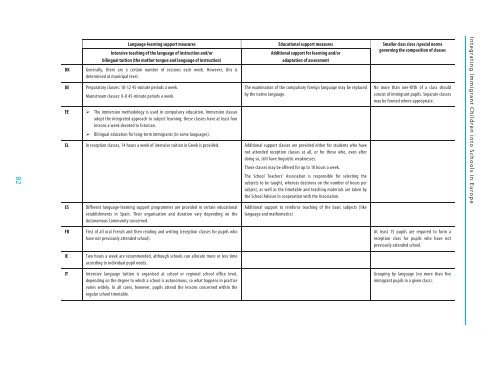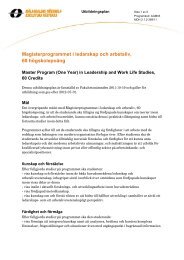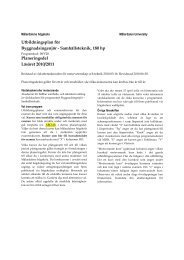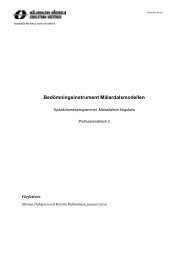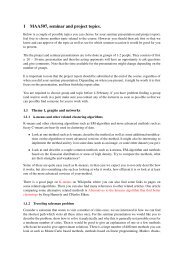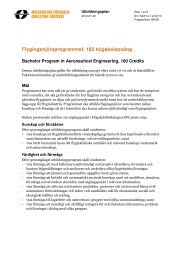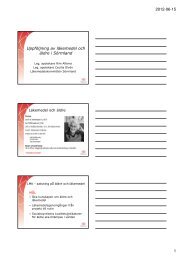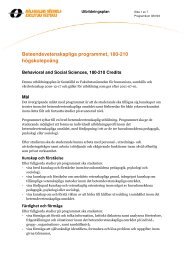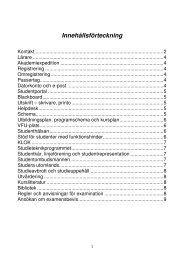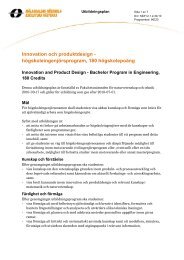Integrating Immigrant Children into Schools in Europe
Integrating Immigrant Children into Schools in Europe
Integrating Immigrant Children into Schools in Europe
Create successful ePaper yourself
Turn your PDF publications into a flip-book with our unique Google optimized e-Paper software.
82DKDEEELanguage-learn<strong>in</strong>g support measuresIntensive teach<strong>in</strong>g of the language of <strong>in</strong>struction and/orbil<strong>in</strong>gual tuition (the mother tongue and language of <strong>in</strong>struction)Generally, there are a certa<strong>in</strong> number of sessions each week. However, this isdeterm<strong>in</strong>ed at municipal level.Preparatory classes: 10-12 45-m<strong>in</strong>ute periods a week.Ma<strong>in</strong>stream classes: 6-8 45-m<strong>in</strong>ute periods a week.The immersion methodology is used <strong>in</strong> compulsory education. Immersion classesadopt the <strong>in</strong>tegrated approach to subject learn<strong>in</strong>g; these classes have at least fourlessons a week devoted to Estonian.Bil<strong>in</strong>gual education for long-term immigrants (<strong>in</strong> some languages).Educational support measuresAdditional support for learn<strong>in</strong>g and/oradaptation of assessmentThe exam<strong>in</strong>ation of the compulsory foreign language may be replacedby the native language.EL In reception classes, 14 hours a week of <strong>in</strong>tensive tuition <strong>in</strong> Greek is provided. Additional support classes are provided either for students who havenot attended reception classes at all, or for those who, even afterdo<strong>in</strong>g so, still have l<strong>in</strong>guistic weaknesses.These classes may be offered for up to 10 hours a week.The School Teachers’ Association is responsible for select<strong>in</strong>g thesubjects to be taught, whereas decisions on the number of hours persubject, as well as the timetable and teach<strong>in</strong>g materials are taken bythe School Advisor <strong>in</strong> cooperation with the Association.ESDifferent language-learn<strong>in</strong>g support programmes are provided <strong>in</strong> certa<strong>in</strong> educationalestablishments <strong>in</strong> Spa<strong>in</strong>. Their organisation and duration vary depend<strong>in</strong>g on theAutonomous Community concerned.Additional support to re<strong>in</strong>force teach<strong>in</strong>g of the basic subjects (likelanguage and mathematics)Smaller class sizes /special normsgovern<strong>in</strong>g the composition of classesNo more than one-fifth of a class shouldconsist of immigrant pupils. Separate classesmay be formed where appropriate.<strong>Integrat<strong>in</strong>g</strong> <strong>Immigrant</strong> <strong>Children</strong> <strong><strong>in</strong>to</strong> <strong>Schools</strong> <strong>in</strong> <strong>Europe</strong>FRIEITFirst of all oral French and then read<strong>in</strong>g and writ<strong>in</strong>g (reception classes for pupils whohave not previously attended school).Two hours a week are recommended, although schools can allocate more or less timeaccord<strong>in</strong>g to <strong>in</strong>dividual pupil needs.Intensive language tuition is organised at school or regional school office level,depend<strong>in</strong>g on the degree to which a school is autonomous, so what happens <strong>in</strong> practicevaries widely. In all cases, however, pupils attend the lessons concerned with<strong>in</strong> theregular school timetable.At least 15 pupils are required to form areception class for pupils who have notpreviously attended school.Group<strong>in</strong>g by language (no more than fiveimmigrant pupils <strong>in</strong> a given class).


